The ASRock DeskMini A300 Review: An Affordable DIY AMD Ryzen mini-PC
by Ganesh T S on April 26, 2019 8:00 AM ESTBAPCo SYSmark 2018
The ASRock DeskMini A300 was evaluated using our Fall 2018 test suite for small-form factor PCs. In the first section, we will be looking at SYSmark 2018.
Prior to describing the benchmark itself, we should quickly address concerns about using the benchmark to test AMD-based systems, given that AMD is not a part of the BAPCo consortium. In fact, AMD has been pretty vocal against the benchmark, with their last salvo appearing in 2016. AMD had quit BAPCo in 2011 over concerns of the GPU not being represented enough in the benchmarks.
Having analyzed the SYSmark 2018 white paper, and actually followed the execution of the benchmark workloads, we can say that SYSmark 2018 does represent possible usage patterns for a PC used in a business / office setting. Even if one were to side with AMD on the scoring aspect, the benchmark's rather unique energy consumption metric accurately represents the efficiency of the system for the realistic workloads. Overall, we believe that SYSmark 2018 is a good benchmark for systems used in certain scenarios; though it goes without saying that we never put too much stock in any one benchmark, which is why we only use it as one of out several benchmarks in our mini-PC reviews.
Anyhow, BAPCo's SYSmark 2018 is an application-based benchmark that uses real-world applications to replay usage patterns of business users in the areas of productivity, creativity, and responsiveness. The 'Productivity Scenario' covers office-centric activities including word processing, spreadsheet usage, financial analysis, software development, application installation, file compression, and e-mail management. The 'Creativity Scenario' represents media-centric activities such as digital photo processing, AI and ML for face recognition in photos and videos for the purpose of content creation, etc. The 'Responsiveness Scenario' evaluates the ability of the system to react in a quick manner to user inputs in areas such as application and file launches, web browsing, and multi-tasking.
Scores are meant to be compared against a reference desktop (the SYSmark 2018 calibration system, a Dell Optiplex 5050 tower with a Core i3-7100 and 4GB of DDR4-2133 memory to go with a 128GB M.2 SATA III SSD). The calibration system scores 1000 in each of the scenarios. A score of, say, 2000, would imply that the system under test is twice as fast as the reference system.
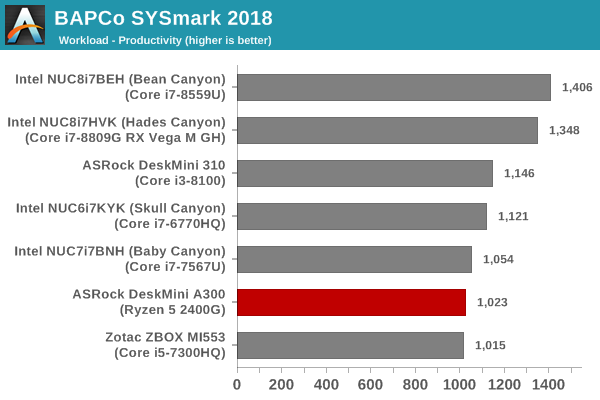
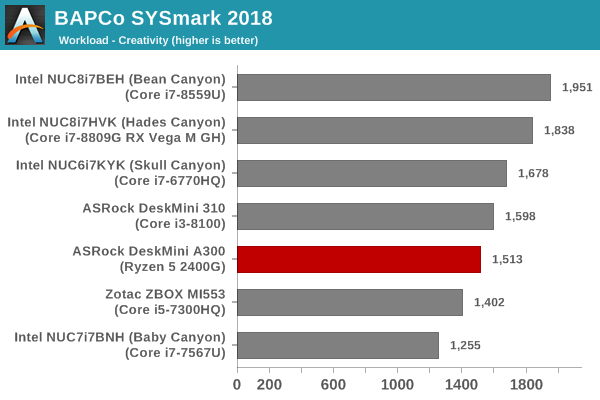
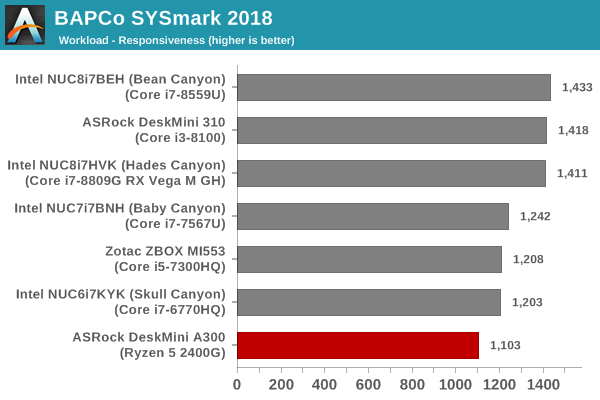
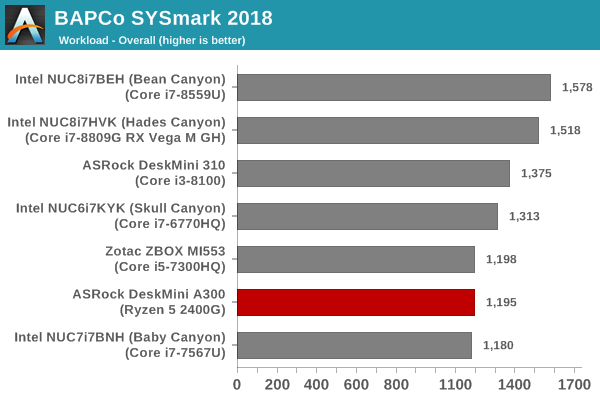
SYSmark 2018 also adds energy measurement to the mix. A high score in the SYSmark benchmarks might be nice to have, but, potential customers also need to determine the balance between power consumption and the efficiency of the system. For example, in the average office scenario, it might not be worth purchasing a noisy and power-hungry PC just because it ends up with a 2000 score in the SYSmark 2014 SE benchmarks. In order to provide a balanced perspective, SYSmark 2018 also allows vendors and decision makers to track the energy consumption during each workload. In the graphs below, we find the total energy consumed by the PC under test for a single iteration of each SYSmark 2018 workload. For reference, the calibration system consumes 5.36 Wh for productivity, 7.71 Wh for creativity, 5.61 Wh for responsiveness, and 18.68 Wh overall.
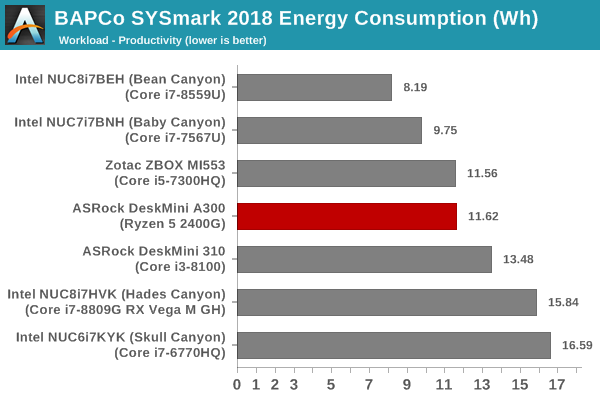


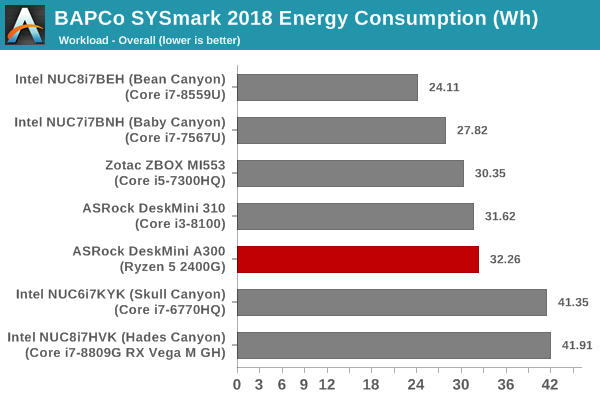
In the rest of the review, our focus will be on comparing the performance of the DeskMini A300 with the Ryzen 5 2400G and the DeskMini 310 with the Core i3-8100. Our builds for the system have approximately the same price point, and they are both contemporary systems. The overall energy consumption for the A300 is only slightly higher than the DeskMini 310, but the benchmark scores are lower. The DeskMini A300 configuration performs as well as the Zotac ZBOX MI553 (with the 45W Core i5-7300HQ) and the Baby Canyon NUC (with the 15W Core i7-7567U). However, those machines consume around 2 to 5 Wh less to achieve those scores.










88 Comments
View All Comments
Haawser - Sunday, April 28, 2019 - link
@oliwek That's the 310, it's an Intel barebones system, not Ryzen.sor - Saturday, April 27, 2019 - link
If you sign up for Newegg notifications you’ll probably have one within a week. I got one of mine about three weeks ago and the other last week.yankeeDDL - Monday, April 29, 2019 - link
I'm just going to throw it as a suggestion.I understand the purpose and the rationale in comparing similarly priced models, and all relatively recent/available, however ... I think it would add an enormous value to "normal" users to be able to somewhat put things in perspective with slightly dated hardware.
I am not saying that we should be able to compare the Ryzen 5 2400G with an 80486, but, to give you an example, I have an A10-8700P and I have been considering an upgrade, but it seems really difficult to find a way to get an idea of just how much faster the 2400G is.
The A10-8700P is certainly not efficient, but it does have 4 cores, and a decent iGPU, already based on the GCN. There's no question that the 2400G will trounce it in efficiency, but is it a worth upgrade?
It is just an example, to indicate that having also 2-3 previous generations in the comparisons would not be such a bad idea, in my opinion. Just a thought.
Irata - Wednesday, May 1, 2019 - link
If you are looking for this type of comparison, planet3dnow de has one between an Athlon 5350 (Jaguar) vs Athlon 200GE. It's in German but maybe you can get useable results using Google translate.They also did a review of the Hewlett-Packard 17-ca1004ng notebook with a Ryzen 5 3500U comparing it to its Bristol Ridge predecessor.
Both show just how far AMD has come with Ryzen.
mikato - Tuesday, April 30, 2019 - link
Ganesh, you didn't talk about noise at all. I feel like that should always be included in these mini PC articles. You have 3 pages on HTPC credentials and 1 page on Power Consumption and Thermal Performance but no mention of noise. How does it compare to the Intel NUC8i7BEH that you mentioned had a noisy fan with any load? Or the ZBOX CI660 which was fanless but had a dull whine and a strange grating sound though it wasn't noticeable beyond 10 feet? Did you think that optional CPU heatsink/fan they included was adequate?By the way, 10 feet isn't close enough. How about 6 feet? If you give one noise impression from 10 feet, you could move a few feet closer and check what it is at 6 feet as well... for future reviews.
If you keep doing these Mini PC reviews, I will keep reading them!
Lucky Stripes 99 - Sunday, May 5, 2019 - link
I was also puzzled at the lack noise testing. One of the reasons I'm looking at mini-STX and thin mini-ITX systems instead of a NUC is because of the fan noise many of those NUC systems suffer from.Some folks have been installing low-profile Noctua CPU coolers in their Deskmini systems and they report that they are "nearly silent", even while under heavy load. I'd really like to know how silent that really is.
werpu - Monday, May 6, 2019 - link
I have a ryzen 2400g mini itx system with the flat noctua, and it is very silent, even under heavy load it is almost not hearable. I however had to add 2 smaller noctuas later in my system because the vrm would get rather hot with my standalone noctua and the case I was using. Still a very silent system and definitely less noise than a nuc.mikato - Tuesday, April 30, 2019 - link
At first I thought Bean Canyon was the best way to go for an HTPC with the performance and power efficiency. But with an idle power usage of 11.24 watts for this DeckMini A300 vs the 8.45 watts of the NUC8i7BEH with Bean Canyon - that difference is so little. As my HTPC, it would be left on and most of the time it would be idling. And the "as configured, no OS" prices in your reviews for these were $465 for the DeskMini A300 and $963 for the NUC8i7BEH...Let's see, your DeskMini A300 had:
G.Skill Ripjaws F4-3000C16D-16GRS 2x8 GB (newegg $100)
Western Digital WD SN500 500 GB (newegg $70)
While your NUC8i7BEH had:
G.Skill Ripjaws F4-3000C16D-32GRS 2x16 GB (newegg $185 - your review listed RipjawsV F4-3000C16-16GRS but I couldn't find that anywhere and the photos in your NUC8i7BEH review showed it was F4-3000C16D-32GRS instead so I think your specs table was incorrect)
Western Digital WD Black 3D NVMe SSD (2018) 1 TB (newegg $238 for the SN750, older 2018 one costs more)
Let's see... that's $185-100=85 and $238-70=168. 85+168=253
So your combined storage and memory choices for the NUC8i7BEH cost $253 more.
And the difference in your overall "as configured, no OS" prices was $963-465=498.
So if I remove the difference in your storage and memory choices, I calculate that the DeskMini A300 is still $498-253 = $245 cheaper!
Sure the A300 doesn't look as nice or compact as the NUC, but that is some solid money.
Irata - Wednesday, May 1, 2019 - link
The Intel models are usually configured with higher end components vs. the AMD based models. Same for laptops where $600 AMD based notebooks go up against $1,600 Intel ones .I guess it's a hold over of the "AMD = budget" days.
mikato - Thursday, May 2, 2019 - link
Well, it's not a laptop. What do you think might be a higher end component here? This is basically a case, motherboard, and power supply, right?